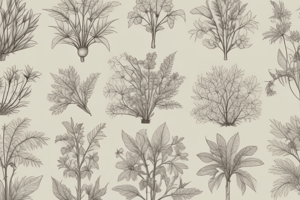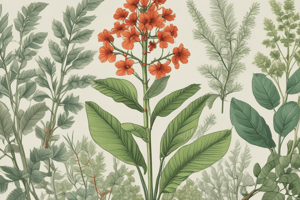Podcast
Questions and Answers
Who is considered the 'Father of Botany'?
Who is considered the 'Father of Botany'?
- Aristotle
- Theophrastus (correct)
- Dioscorides
- Robert Hooke
Dioscorides wrote 'De Materia Medica', which is a comprehensive guide to animal studies.
Dioscorides wrote 'De Materia Medica', which is a comprehensive guide to animal studies.
False (B)
In what century did Robert Hooke invent the microscope?
In what century did Robert Hooke invent the microscope?
17th century
In A.D. 60, Dioscorides wrote 'De Materia Medica', which described approximately _____ medicines.
In A.D. 60, Dioscorides wrote 'De Materia Medica', which described approximately _____ medicines.
Which of the following statements about Johannes van Helmont's experiment is true?
Which of the following statements about Johannes van Helmont's experiment is true?
Interest in botany declined during the European Renaissance.
Interest in botany declined during the European Renaissance.
What was the significant finding of van Helmont's experiment over five years with the willow tree?
What was the significant finding of van Helmont's experiment over five years with the willow tree?
Match the botanist with their contribution:
Match the botanist with their contribution:
What did green plants absorb from the atmosphere?
What did green plants absorb from the atmosphere?
Chlorophyll was discovered in 1847.
Chlorophyll was discovered in 1847.
What is the primary role of plants in ecosystems?
What is the primary role of plants in ecosystems?
Photosynthesis produces oxygen as a byproduct.
Photosynthesis produces oxygen as a byproduct.
Who is known as the 'Father of Genetics'?
Who is known as the 'Father of Genetics'?
The process of photosynthesis was first elucidated by ______.
The process of photosynthesis was first elucidated by ______.
What is the significance of carbon sequestration by plants?
What is the significance of carbon sequestration by plants?
What significant discovery did Alexander Oparin make in 1936?
What significant discovery did Alexander Oparin make in 1936?
Plants are essential for the __________ balance on Earth.
Plants are essential for the __________ balance on Earth.
Which of the following is NOT a benefit of studying plants?
Which of the following is NOT a benefit of studying plants?
Darwin's theory of evolution is commonly referred to as 'survival of the fittest'.
Darwin's theory of evolution is commonly referred to as 'survival of the fittest'.
Match the year with the corresponding discovery:
Match the year with the corresponding discovery:
Match the ecological roles of plants with their descriptions:
Match the ecological roles of plants with their descriptions:
In 1865, Mendel's results showed that offspring inherit one unit for each trait from each of their ______.
In 1865, Mendel's results showed that offspring inherit one unit for each trait from each of their ______.
Which type of forest is known as a major carbon sink?
Which type of forest is known as a major carbon sink?
How does the loss of plant species affect ecosystems?
How does the loss of plant species affect ecosystems?
What is a significant benefit of high-yielding, disease-resistant crops?
What is a significant benefit of high-yielding, disease-resistant crops?
Plants are not important for soil conservation.
Plants are not important for soil conservation.
Name one compound derived from plants that is used in modern medicine.
Name one compound derived from plants that is used in modern medicine.
Certain plants, particularly ______, have symbiotic relationships with nitrogen-fixing bacteria.
Certain plants, particularly ______, have symbiotic relationships with nitrogen-fixing bacteria.
Match the following terms with their descriptions:
Match the following terms with their descriptions:
What is one benefit of biofuels derived from plants?
What is one benefit of biofuels derived from plants?
Ethnobotany emphasizes the importance of preserving traditional knowledge.
Ethnobotany emphasizes the importance of preserving traditional knowledge.
How do plants contribute to soil health?
How do plants contribute to soil health?
What is the process called where plants absorb water and release it as vapor through leaves?
What is the process called where plants absorb water and release it as vapor through leaves?
Forests do not have any impact on regulating water flow.
Forests do not have any impact on regulating water flow.
Name a marine plant that contributes to habitat creation in coral reefs.
Name a marine plant that contributes to habitat creation in coral reefs.
The process through which plants are used in traditional medicine has been passed down through __________.
The process through which plants are used in traditional medicine has been passed down through __________.
Match the following plant-related terms with their descriptions:
Match the following plant-related terms with their descriptions:
Why are biodiversity hotspots important?
Why are biodiversity hotspots important?
Plants only have ecological importance and do not contribute to cultural practices.
Plants only have ecological importance and do not contribute to cultural practices.
What example is given for a plant that has cultural significance in Hinduism?
What example is given for a plant that has cultural significance in Hinduism?
Study Notes
What is Botany?
- A branch of biology focused on the study of plants: structure, properties, biochemical processes.
- Involves plant classification, diseases, and interactions with the environment.
- Forms the foundation for applied sciences like agriculture and forestry.
History of Botany
Pre-17th Century
- Theophrastus, known as the "Father of Botany," wrote significant works on plant classification in the 4th Century B.C.E.
- Dioscorides authored "De Materia Medica" in A.D. 60, documenting medicinal plants, which served as a guide for 1500 years until the discovery of the microscope.
17th Century
- Interest in botany declined briefly but revived during the European Renaissance, leading to an increase in scientific publications.
- Johannes van Helmont conducted an experiment in 1640 measuring water uptake in a willow, concluding most plant mass originated from water.
- Robert Hooke invented the microscope in 1665, enabling the study of cells and demonstrating the role of plants in absorbing carbon dioxide and releasing oxygen.
19th Century
- Chlorophyll was discovered in 1818, marking a significant advancement in understanding plant biology.
- The potato blight in the 1840s emphasized the need to study plant diseases.
- Charles Darwin proposed his theory of evolution around 1859, while Gregor Mendel's work with pea plants in 1865 laid the groundwork for genetics.
20th Century to Present
- Discovery of the nitrogen cycle processes in the early 20th century advanced agricultural knowledge.
- The identification of chlorophyll types in 1903 enhanced understanding of photosynthesis.
- Plants are continually studied for crop improvement, ecological balance, and discovering new medicines.
Importance of Studying Plants
Ecological Importance
- Foundation of Ecosystems: Plants are primary producers, forming the base of food chains and providing habitats.
- Oxygen Production: Photosynthesis contributes to atmospheric oxygen critical for respiration in living organisms.
- Carbon Sequestration: Plants absorb CO₂, helping mitigate climate change and store carbon.
Economic Importance
- Agriculture: Understanding plant biology is essential for food production, breeding, and pest management.
- Medicinal Uses: Many medicines derive from plant compounds; ethnobotany studies indigenous uses of plants.
- Industrial Uses: Plants supply materials for textiles, biofuels, and sustainable resources, impacting economies.
Environmental Importance
- Soil Conservation: Plant roots prevent erosion and enhance soil fertility through organic matter contributions.
- Water Cycle Regulation: Plants participate in transpiration, influencing precipitation and climate.
- Habitat Creation: Plants maintain habitats, supporting biodiversity in ecosystems.
Cultural and Aesthetic Importance
- Cultural Significance: Plants are integral to cultural traditions, rituals, and symbols (e.g., lotus in Hinduism).
- Traditional Medicine: Indigenous knowledge of medicinal plants informs drug development and preserves文化 heritage.
- Aesthetic Value: Plants enhance landscapes and human environments, contributing to well-being and quality of life through horticulture.
Studying That Suits You
Use AI to generate personalized quizzes and flashcards to suit your learning preferences.
Related Documents
Description
This quiz covers the fundamentals of botany, including definitions, classifications, and the history of plant study. Explore the significant role of botany in agriculture and forestry, as well as the study of plant diseases and their environmental interactions. Test your knowledge on the key concepts introduced in Unit 1.


